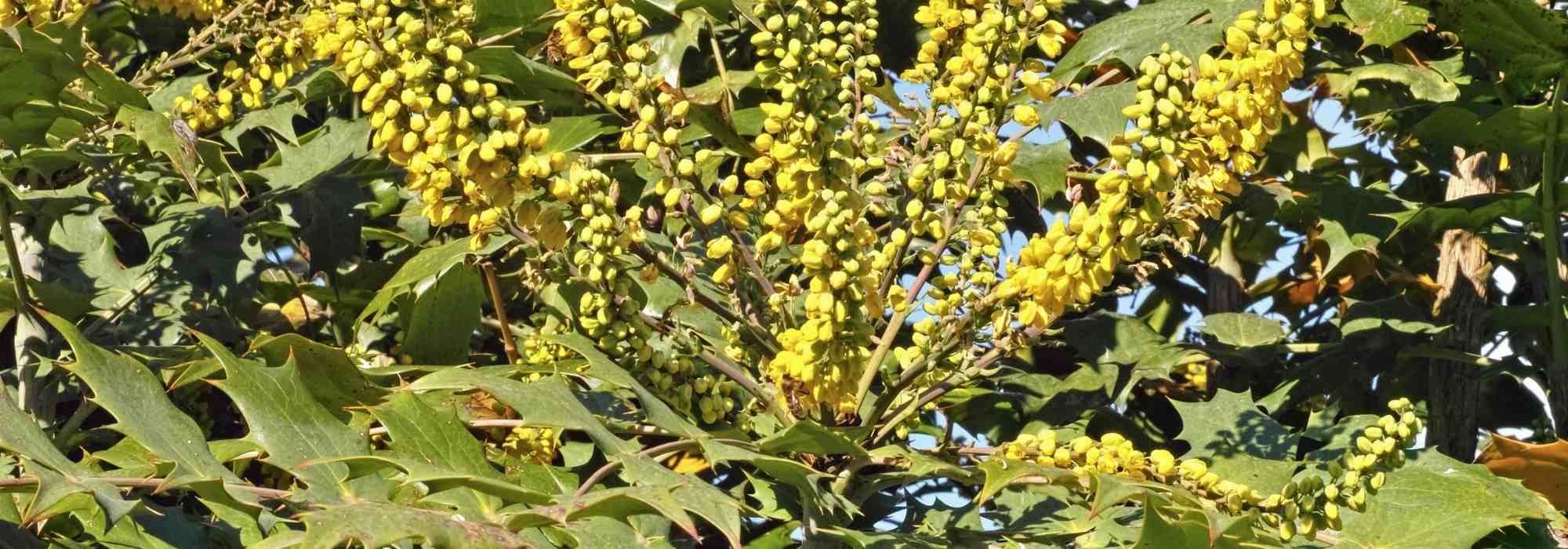
Mahonia: 7 companion planting ideas
To showcase this distinctive shrub in the garden
Contents
Mahonia is an evergreen shrub with winter flowering in the form of beautiful, bright yellow clusters. Graphic in its compound foliage and erect habit, it brings real interest to the garden at that time of year. Long neglected or even disliked for its thorny, somewhat old-fashioned aspect, Mahonia deserves rediscovery: it offers distinct foliage colours, staggered and scented flowering depending on variety, varying sizes and excellent hardiness. It can also colonise unforgiving areas of the garden, mainly in shade and part shade, in slightly acidic soil. Among the some 70 known species, the main ones used are Mahonia x media, Mahonia aquifolium (holly-leaved Mahonia), and Mahonia lomariifolia.
A newcomer even changes the game with silky foliage! Each has a strong character for very different moods.
How to make best use of this unusual bush in the garden? We offer several planting ideas to exploit its great potential: in borders, as a solitary specimen, integrated into a hedge, and to turn this original ornamental bush into a standout feature in your garden.
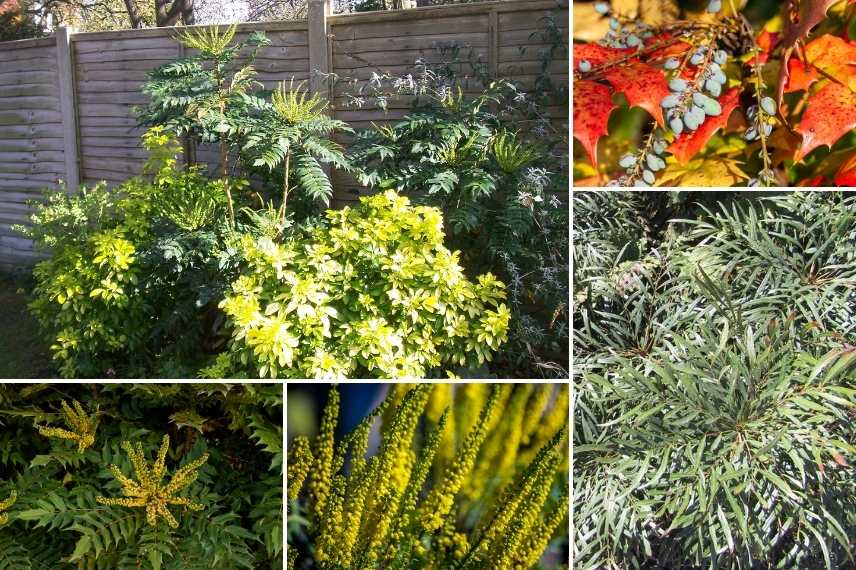
Superb shurbs all year long as evergreen, graphic, and exceptionally radiant in winter! (Photos: L. Enking)
In a tropical border
The singular character of Asian-origin Mahonias (Mahonia japonica, Mahonia x ‘Charity’), their remarkable habit and their prominent, pinnate foliage made up of long dentate leaflets make them choice bushes for planting in a tropical- or exotic-inspired border. Spiny evergreen foliage brings originality and a graphic quality that pairs perfectly with exuberant foliage in an exotic scheme.
Dare to make them one of main attractions of a lush border by pairing with structural plants, large leaves of Farfugiums or Asarums, graphic dissected foliage such as Acanthes or Fatsias. You can adapt this bed to several exposures, tailoring plantings to each situation, and combine a range of warm-toned flowerings in yellow, orange or purple that complement bright yellow inflorescences of Mahonia and enhance tropical note. Add a few yellow botanical tulips or grasses to these areas. Choose plants that enjoy well-drained, cool and slightly acidic soil.
Some planting ideas, with staggered flowerings over several months :
- In shade : Aucuba, Fatsias, ferns, Farfugiums, tree ferns, Colocasias, Astilboides tabularis, etc…
- Partial shade : Phormiums, Acanthes, Tetrapanax, Heydichiums, Euphorbias griffithi ‘Dixter’, Cannas…
- In sunnier positions : Mahonia Aquifolium ‘Apollo’, Euphorbia characias, Phormiums, Cannas, Pinus mugo, Alstroemerias, Yuccas, Kniphofia ‘Dorset Sentry’..
In mild climates, you can even plant Cycas revoluta, castor beans, Clivias, Strelitzias, or grow elsewhere in large pots to be moved under cover for winter…
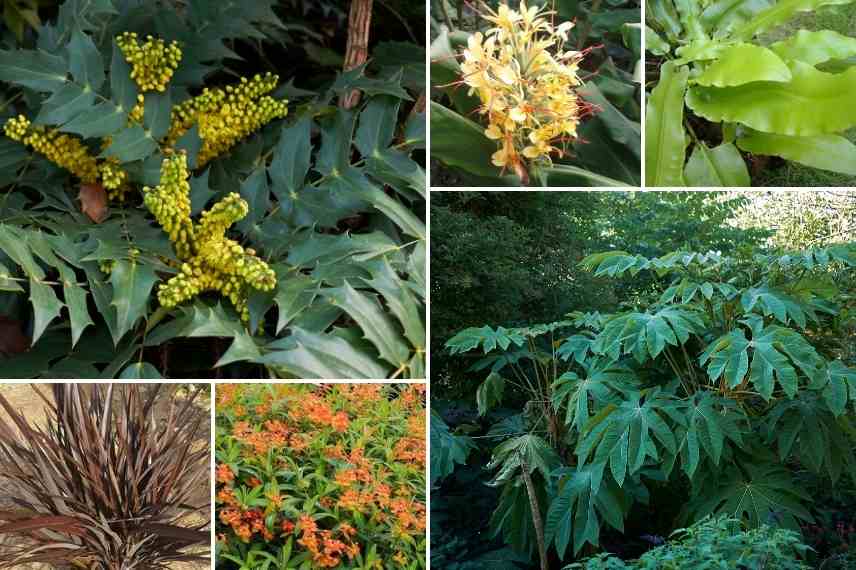
An example of a planting combination : Mahonia x ‘Winter Sun’ (flowering between December and February), Phormium tenax ‘Special Red’, Euphorbia griffithii ‘Dixter’ (flowering in May/June), Hedychium (flowering in late summer), Hart’s-tongue fern, Tetrapanax
Read also
Mahonia : planting, pruning and careOn its own
Mahonia is truly sculptural when choosing a fairly tall variety with an erect habit, which reveals the slightly channelled woody trunks topped by the branches bearing foliage and clusters of flowers in mid-winter. The Asian species, Mahonia x media (a cross-breeding between Mahonia japonica and Mahonia lomariifolia) and especially Mahonia lomariifolia, reaching about 3 m in height, are particularly suitable for display as specimens. Mahonia lomariifolia, native to China, with its incredibly long foliage (up to 60 cm), has enormous potential for this specimen use where foliage is prized year-round. Its intense yellow flowering is one of the longest in mid-winter (from late autumn to mid-winter), and it emits an intense honey scent. For an even more spectacular effect, three specimens can be grouped together.
Reserve an open position in partial shade within a large garden or along a façade or a light-coloured wall to showcase it. It will flower a little less when exposed to full sun.

An architectural staging for these Mahonia plants on a house façade (Photo: W. Cutler)
Discover other Late-flowering shrubs
View all →Available in 0 sizes
Available in 1 sizes
Available in 1 sizes
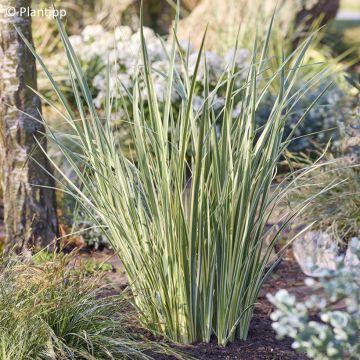
Available in 1 sizes
Available in 1 sizes
Available in 1 sizes
Available in 1 sizes
Available in 2 sizes
Available in 1 sizes
Available in 1 sizes
In a small garden
Modest size of certain cultivars predisposes them to occupy small spaces, whether city gardens, patios, small gardens or contemporary terraces. For this use, the Mahonia eurybractea (or confusa) ’Soft Caress’ and ‘Nara Hiri’, are a boon: at about 1 m in height, they are even suitable for planting in pots, not least because their growth is slow. Their very airy, graphic foliage, without thorns, resembles that of a fern, which will naturally be paired with them. Their magnificent narrow olive-green foliage, slightly bluish, allows them to be paired with other glaucous or contrasting foliage for a refreshing, decidedly modern atmosphere in a shady area: Heucheras or Physocarpus in purple, graphic foliage of dwarf conifers such as Chamaecyparis pisifera ‘Kaatje’ or the zesty Choisya ‘Aztec Gold’. A few Nandinas (sacred bamboos) will respond nicely with their airy habit, as will small Japanese maples and Helleborus foetidus with very dissected foliage.
Flowering in lemon yellow in early autumn, you can create harmonies with long summer and winter flowering in these bright tones: Corydalis lutea, Helleborus orientalis ‘Double Yellow’.
Another option among compact Mahonias, Mahonia nitens ‘Cabaret’, less graphic admittedly, but turning purple in winter, flowers early with a superb coppery-orange display (between August and October). This cultivar should be planted in medium of the border because of its prickly foliage.
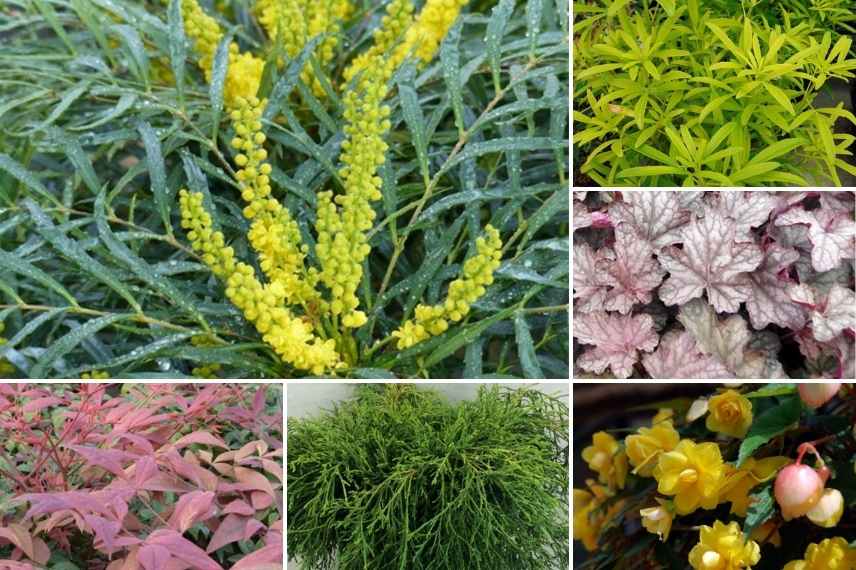
Mahonia ‘Soft Caress’ lends itself ideally to small-space design: here with Choisya ‘Aztec Gold’, purple Heucheras, Nandinas ‘Obsessed Seika’, dwarf Chamaecyparis pisifera ‘Kaatje’, and yellow begonias
In woodland
Native to North America’s understoreys and moist soils, Mahonia aquifolium naturally thrives in such nutrient-rich media. This modest-sized species – the smallest of the Mahonia, about 1 m in every direction – naturalises easily in areas of partial shade, which it will brighten with its spring flowering (in March–April). With its small foliage turning crimson in winter, it pairs easily with other bushes such as Euonymous alatus, holly with similar foliage, Berberis as well as Chimonatus praecox (both of the same family Berberidaceae), and Cornus mas ‘Jolico’. Choose the Mahonia aquifolium ‘Apollo’ with golden-yellow flowering and erect clusters slightly larger than the typical species.
Early bulbs or early perennials such as Eranthis hyemalis or botanical narcissi, planted in drifts, will reinforce the understorey atmosphere, as will a creeping ivy at home in this natural medium.
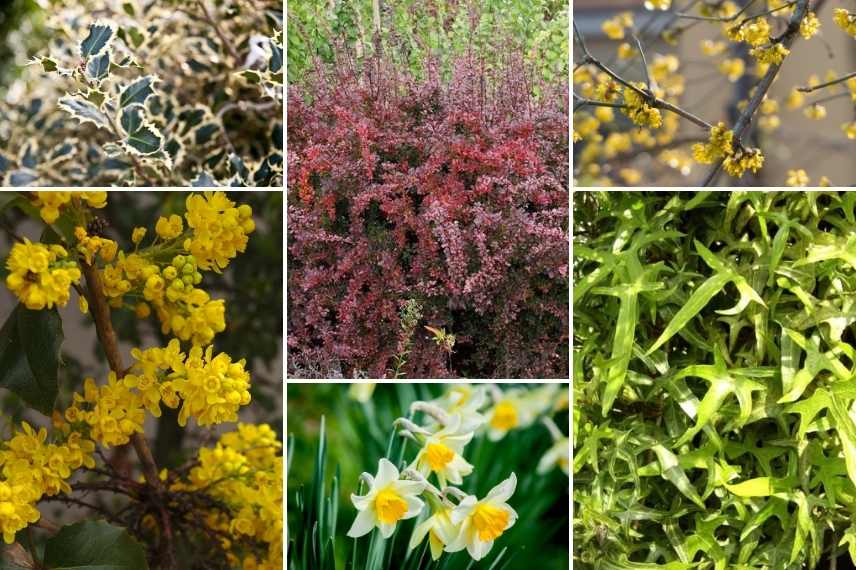
Charming association of a Mahonia aquifolium, with a variegated holly, a Berberis thunbergii, a few daffodils, a Cornus mas and a superb ivy Hedera helix Sagittifolia.
As a clump or single-species defensive hedge
What if you highlighted the graphic aspect of Mahonia in a clump or single-species hedge? A small challenge worth taking on when planted in a series of at least five plants, for example: it then takes on real presence and provides a strong identity to a clump, a dividing or boundary hedge in a large garden, even an awkward bank you do not know what to do with (its dense root system helps hold soil, ideal for banks).
Ce sont les Mahonia x media ou lomariifolia qui sont adaptés pour cet usage, les plus hauts et piquants à souhait. L’effet sera réellement spectaculaire au bout de quelques années. Soyez patients, car cet aménagement en groupe d’une même variété apporte au jardin un caractère unique, et une fantaisie lumineuse hivernale ! Un simple couvre-sol caduc ou persistant le mettra en valeur : Ranunculus ficiaria, Hypericum tricolor…
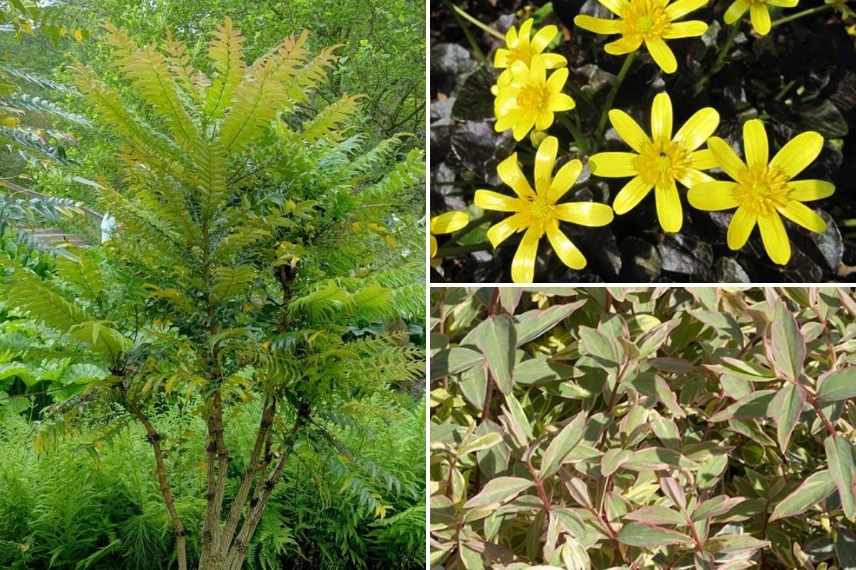
An idea for a clump planting, flowering in spring: Mahonia lomariifolia, Ranunculus ficaria ‘Brazen Hussy’ and tricolour St John’s wort
In a yellow-and-blue border
Mahonias, all flowering yellow, are the perfect complement to blue-dominated borders: they will provide interesting evergreen foliage and staggered flowering, from July/August to March, by mixing two or three varieties. Their bluish fruits will extend this plant palette once flowering has finished.
You can thus create very different borders, depending on whether creating or supplementing a Mediterranean-flavoured border or a more natural one. Ideally, take advantage of Mahonias’ appeal in borders exposed to partial shade, in well-draining soils: pair, for example, a Mahonia japonica and a Mahonia ‘Soft Caress’ with the blue of Ceanothus pallidus ‘Marie Blue’, rhododendrons, Caryopteris (‘Heavenly Blue’), grape hyacinths and the golden-yellow to orange of Berberis linearifolia ‘Orange King’, some avens, daylilies, even perennial orchids (Calanthe tricarinata).
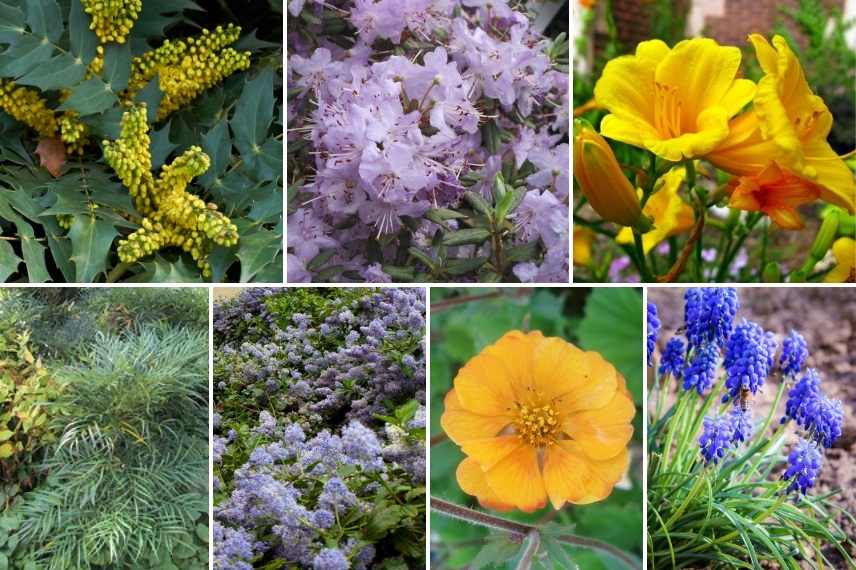
Mahonias x media and ‘Soft Caress’ accompany winter, spring and summer flowering; grape hyacinths, rhododendrons, avens, daylilies…
In a large shrub border
With Mahonia russellii, native to Central America, you can create an original shrub border: this little-known Mahonia variety is one to discover for your large borders: this handsome bush with supple, narrow leaves flowers in late winter, between March and April, covering itself in small flowers quite different from other Mahonias — very delicate, cream-coloured; they are trailing on the branches. The foliage is also of interest, first pink, then purplish, finally dark green in summer. Slow growth like all Mahonias, it will eventually reach 3 to 4 metres in height. It will be in good company with other large bushes such as an orange- or yellow-flowered Hamamelis that will precede its spring flowering, Osmanthe fragrans Aurantiacus and a bee tree flowering in summer.
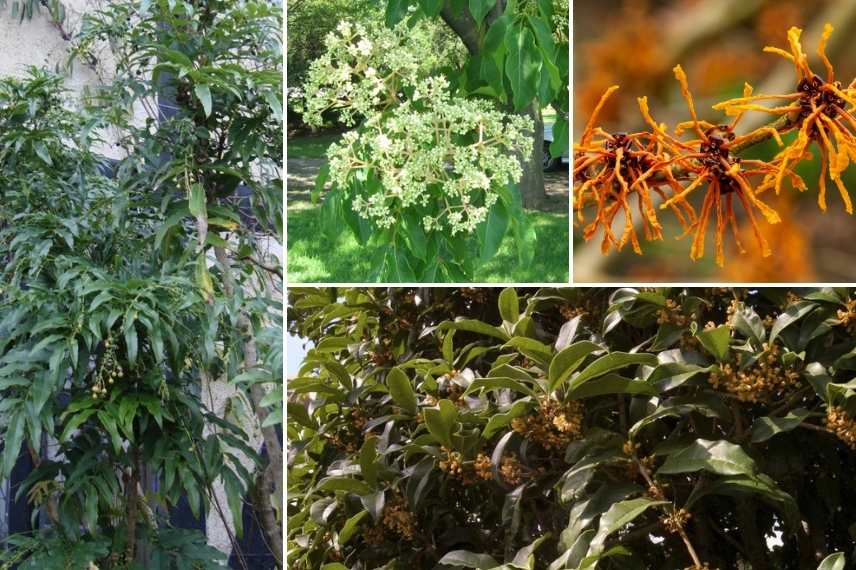
Mahonia russellii, Bee tree (Euodia dianelii), Hamamelis x intermedia ‘Aphrodite’, Osmanthus fragrans ‘Aurantiacus’
- Subscribe!
- Contents
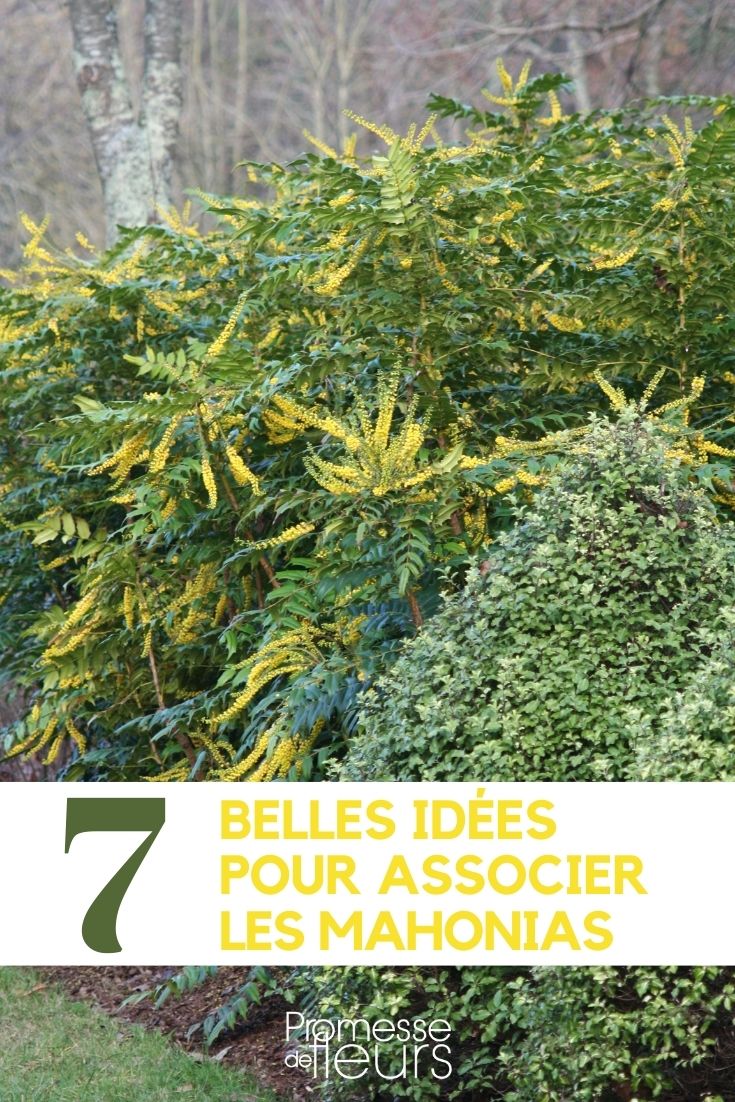

































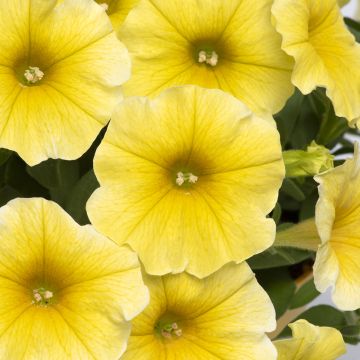
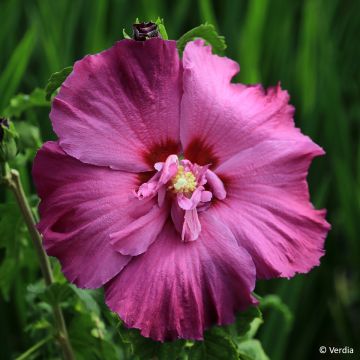
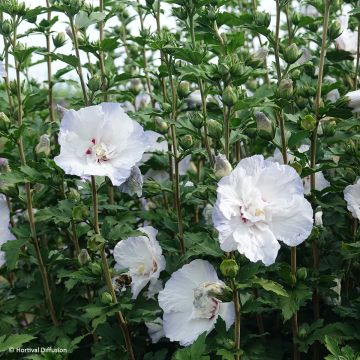


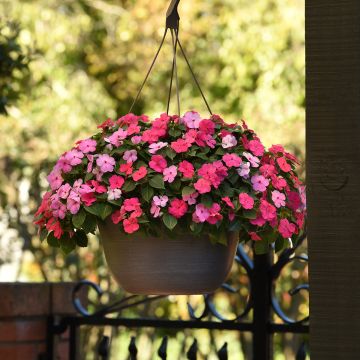
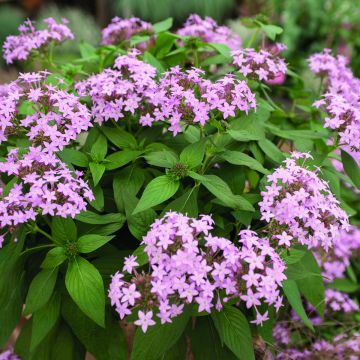
Comments